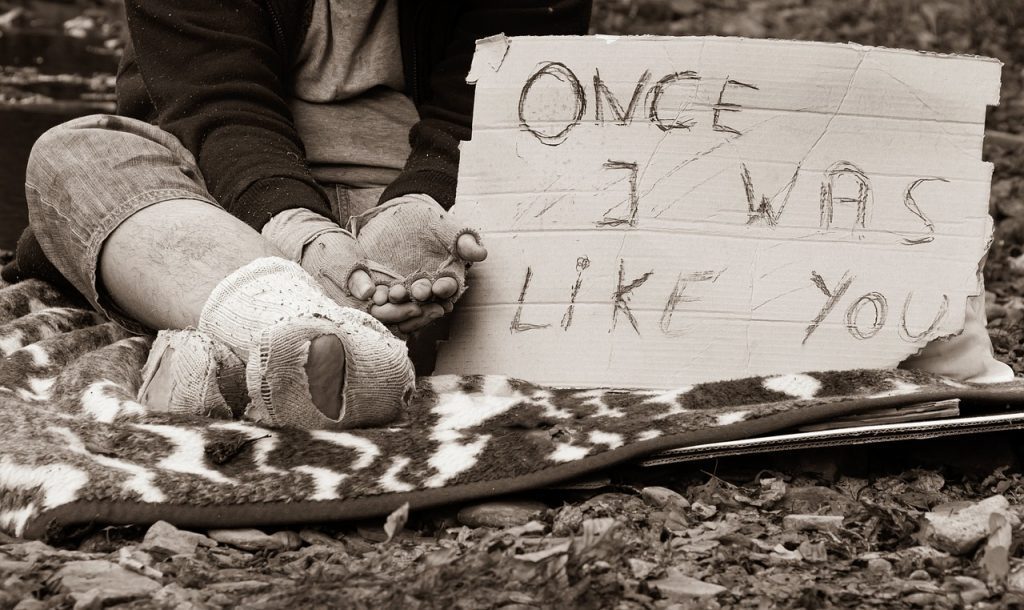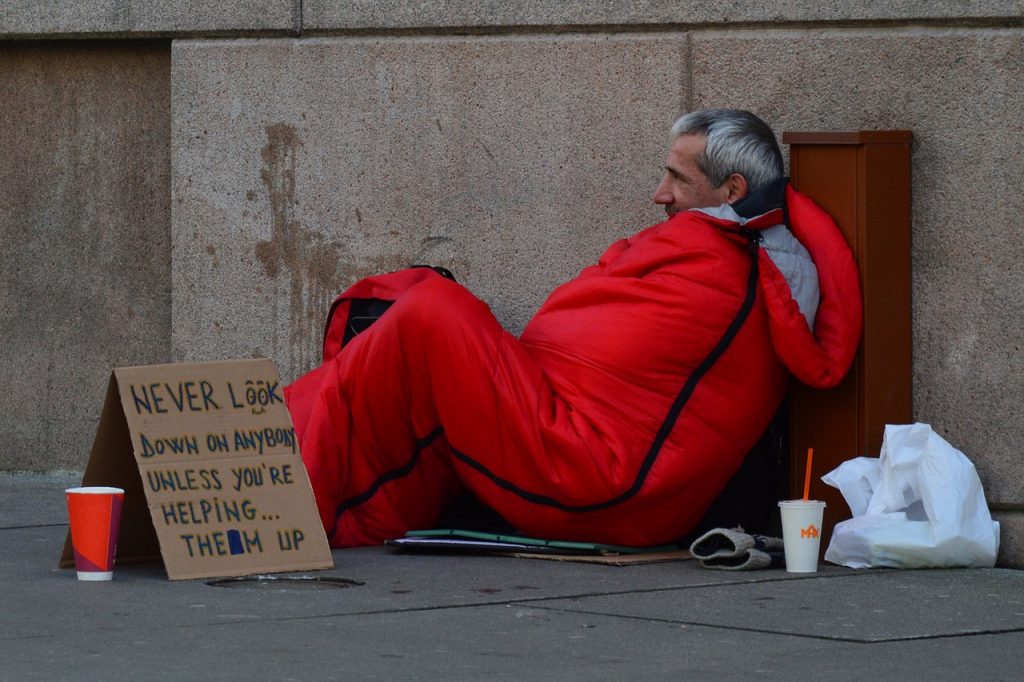Last month, in July 2023, the government admitted that homelessness in England has reached a 25 year high – the highest number since it starting record keeping.
But why is there homelessness in the UK and why is it rising?
Homelessness is a man-made crisis, the direct result of government policy.
Cutting Social Housing To Pay For Unaffordable Housing
Successive austerity governments reneged on their responsibility to build new social housing. In 2010 the Conservative-led coalition slashed funding for subsidised housing by 60% and redirected the remaining money away from social rent and towards more expensive so called “affordable rent” housing which ordinary people cannot afford.
As a result forty councils in England saw no social rent housing built in five years in the wake of these government funding cuts, and another 122 local authority areas – more than a third of all councils in England – each saw under 20 social rent properties built or acquired over the five years.
The coalition government also limited councils’ ability to borrow to build housing, further hitting supply.
Just 7,500 new social rent homes were delivered last year, while more than one million households are stuck on social housing waiting lists in England – some 4.2 million people, according to the National Housing Federation.
In fact more social homes are lost than built each year due to demolition and sales – there was a net loss of 14,100 social homes in 2021/22 in England.
Preventing Councils From Using Empty, Unused Properties
Powers given to local councils to take over unused, empty properties for fixed periods of time using Empty Dwelling Management Orders (EDMO) has been diluted over time since the 2010 coalition government came to power.
The regulations originally stated that a house simply had to be unoccupied for six months and not likely to be occupied in the near future, with a good chance that if an EDMO was granted it would be put back into use. However, this period was extended by the Coalition government to at least 2 years, with the new policy coming into force in November 2012. The new regulations also required that the property being heavily vandalised or actively used for “antisocial” purposes, and that there is local support for the use of an EDMO. Once an EDMO has been granted the authority works with the owner to try and agree a way to put the property back into use. When a tenant has been found under the EDMO, the rent after maintenance costs goes to the owner.
Due to this dilution of powers both Croydon and Lambeth are in the top 5 of a league table of shamed boroughs with most empty, unused homes. Croydon with 5,700 homeless people has a staggering 1,606 unused, empty homes! Lambeth is even worse with 1,820 empty homes.
Chris Bailey, from Action on Empty Homes, said the true figure could be 4x higher. “The number started rising when the government stopped more active discouragement of the practice.” So if Croydon Council could make use of those empty, unused homes to house Croydon’s homeless, then all the homeless people in our borough would have a home.
Rent Surge - One Family Evicted Every 8 Minutes
With no new social houses being built; and empty, unused houses allowed to stay empty; and the average cost of a house in Croydon beyond people reach at £417,000, people are forced to rent in the private sector. This has resulted in rents surging to historic highs. In London its up 15.2% from last year, 13.9% in Croydon and a staggering 16.5% in Lambeth – the 4th highest rent rise in the country.
Private landlords are unscrupulously evicting tenants mid-lease just to hike the rents. The Renters (Reform) Bill designed to ban Section 21 no fault evictions that was meant to be introduced in the 2019-2021 parliamentary session, has stalled in parliament with no interest from the government in passing it any time soon. Families who receive Section 21 notices have only two months to move out of their home, and landlords do not have to give a reason for evicting them. Every day 172 private renting families in England are handed a Section 21 no-fault eviction notice by their landlord – that is one every eight minutes.
Newsnight interviewed a couple who live in a rented home for the last 4 years. Their contract was capped at a 5 percent per year rent increase. But the landlord demanded a 12 percent increase which they couldn’t afford. So they cited their contract, but that didn’t stop them being evicted under Section 21 no fault eviction rule.
In total 24,060 households were threatened with homelessness as a result of a Section 21 no-fault eviction in the last year – up by 21% compared to the previous 12 months.
In the worst case scenario, families are left sleeping rough on the streets – in doorways and bus shelters. Rough sleeping households went up 18.2% last year. In Croydon the figure is higher at 21%.
The government’s Official Statistics Rough sleeping snapshot figure ( published Feb 2023) is even worse, showing a 26% rise nationally, with rough sleepers in Croydon increasing by an incredible 182% – one of the highest rises in the country.
Structural Racism
Add to the mix the structural racism present at each stage, and we see that a disproportionately high number of ethnic minorities are being made homeless – in Croydon 3 out of every 4 families being made homeless or threatened with homelessness is non-white, whereas the population of Croydon is predominantly white.
Piggy Bank For The Rich
We are in homelessness crisis today as a result of decades of government decisions engineered to turn our housing system into a piggy bank for the rich, rather than prioritising everyone’s right to a secure home.
Other Interesting Posts:
 “Let my best teacher see my painting” – 6 year old writes to HMP Bronzefield
“Let my best teacher see my painting” – 6 year old writes to HMP Bronzefield
 Free the #Filton10 – Unjustly Imprisoned for 67 Day
Free the #Filton10 – Unjustly Imprisoned for 67 Day
 Unjustly Imprisoned For Two Months – #Filton10 Day 60
Unjustly Imprisoned For Two Months – #Filton10 Day 60
 #Filton10 – Day 46
#Filton10 – Day 46
 Children send paintings to their “best” teacher #Filton10
Children send paintings to their “best” teacher #Filton10
 #Filton10 – Day 39 – Malcolm X in Gaza
#Filton10 – Day 39 – Malcolm X in Gaza
 Why is the Met running ‘off the books’ facial recognition surveillance of #Filton10 Palestine protest?
Why is the Met running ‘off the books’ facial recognition surveillance of #Filton10 Palestine protest?
 Charged, Found Guilty & Sentenced – But Still A Police Officer
Charged, Found Guilty & Sentenced – But Still A Police Officer
 Campaign To Abolish Reporting
Campaign To Abolish Reporting
 Stop Rwanda Deportations
Stop Rwanda Deportations
 Pupils And Teachers – None Are Spared
Pupils And Teachers – None Are Spared
 The Invisible One In Seventeen
The Invisible One In Seventeen





